 |
  |
 |
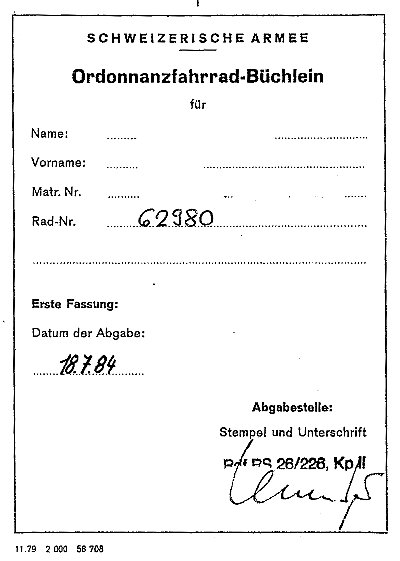 |
Stil working on it
Hi Bicycle fans
in the English speaking parts of our small world. Specially for
you I did try to translate the German Manual of the military
"Ordonnanzfahrrad" user in the Swiss Army.
I did get a copy as PDF file and had
to make first TXT files from that one, page by page. Than I did
scan them back as readable PDF files and did some translation
with Microsoft Word. So it will not be perfect but who is?
Ofcourse it did not work this way. Any suggestion to make it better
is welcome. Hope you like it. Please help me to translate this.
Ben van Helden 2006
|
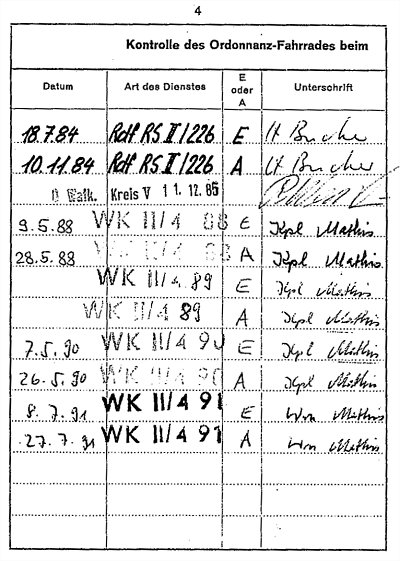 |
|
|
|
|
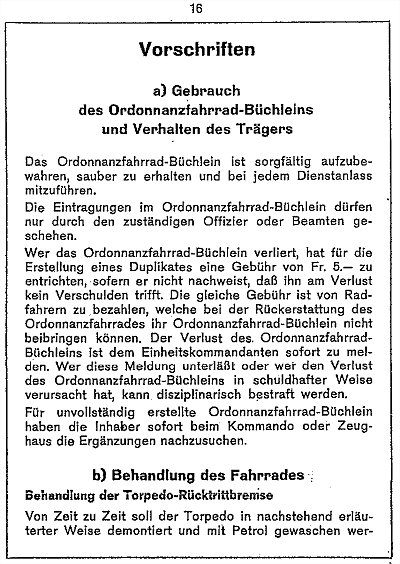 |
Regulations
a)
Use
of the Ordonnanzfahrrad-booklet
and behaviour of the user
The
Ordonnanzfahrrad booklet is to be kept carefully kept clean and
carry with each service cause.
The entries in the Ordonnanzfahrrad booklet may happen only by
the responsible officer or Officials .
Who looses the Ordonnanzfahrrad booklet, has to pay Fr. 5 for
the production of a duplicate, if it do not prove that at the
loss no being to blame for meets it.
Those same fee is to be
paid from cyclists to, who during the restitution of the
Ordonnanzfahrrad their Ordonnanzfahrrad booklet not to teach
know. The loss of the Ordonnanzfahrrad booklet is the commander
of unit immediately to announce. Who this message omits or who
the loss of the Ordonnanzfahrrad booklet in culpable Way caused,
can be disciplinarily punished. For incomplete provided
Ordonnanzfahrrad booklets have the owners immediately with the
command or To seek arsenal the additions restitution of the
Ordonnanzfahrrad their Ordonnanzfahrrad booklet not to teach
know. The loss of the Ordonnanzfahrrad booklet is the commander
of unit immediately to announce. Who this message omits or who
the loss of the Ordonnanzfahrrad booklet in culpable Way caused,
can be disciplinarily punished. For incomplete provided
Ordonnanzfahrrad booklets have the owners immediately with the
command or t seek arsenal the additions.
b) Treatment the bicycle
Treatment that Torpedo resignation brake
Occasionally that is torpedo in below described way dismantled
and with Petrol are washed
|
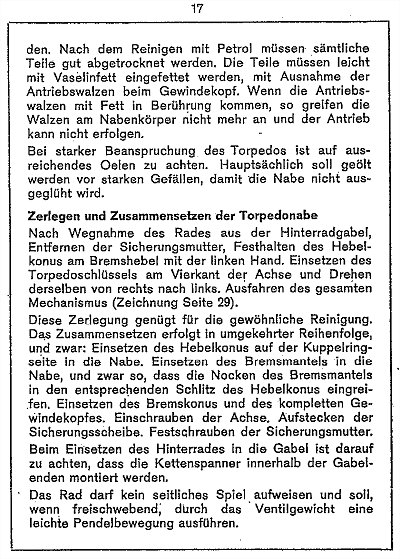 |
After the cleaning with Petrol all parts must well dried. The
parts must lightly greased with Vaseline, with exception of the
roll drives with the thread head. If the roll drives come into
contact with the fat, then the rollers at the hub body do not
seize no more on and the drive cannot take place.
In the case of strong demand the torpedo is to be paid attention
to sufficient oiling. Mainly is to be oiled before strong
downward gradients, so that the hub out one does not glow.
Divide and Build up for the torpedo hub
After removal of the wheel from the rear wheel fork removing the
locknut holding of the lever-konus at the brake lever with the
left hand. Begin the torpedo key at the square of the axle and
tricks of the same from right to the left. Drive out the entire
mechanism (drawing page 29)
This dismantling been sufficient for the usual cleaning building
up takes place in more in reverse sequence: Insert lever-konus
on the Cupola ring side into those Hub, so that the cams of the
break-shoes in the appropriate Slot lever-konus intervene.
Begin the break konus and the complete thread head. Screw in for
the axle. Attach the lock washer. Bolt on the locknut.
When inserting the rear wheel into the fork it is to be made
certain that the chain tensioned within the fork ends to be
installed.
The wheel may not do lateral play exhibit and is, if freely
floating by the valve weight an easy oscillating motion
implement.
|
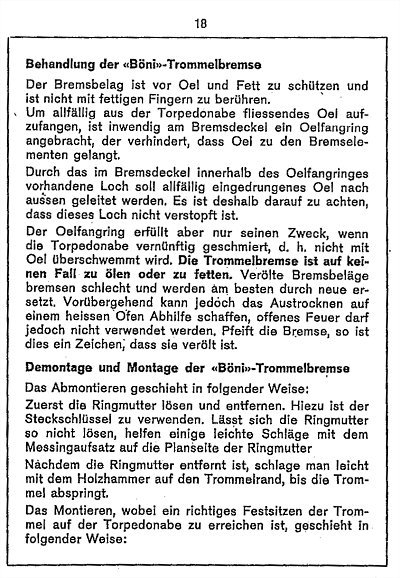 |
Treatment of the <<B÷ni>> drum brake.
The brake lining is to protect for oil and fat and is not to be
touched with greasy fingers.
to catch flowing oils from the Torpedˇ hub, is inside the
brake cover a oil catch ring attached, which prevents that oil
reached the brake shoes.
By in
Brake cover within oils fang struggle existing hole
is possible penetrated oil outward led become. It is to be made
certain therefore that this hole is not clogged.That oil catch ring fulfilled however only his purpose, if the
torpedo hub reasonably lubricated, D. h. not with oil one
inundates.
The drum brake is up no case to oil or too greasy
oiled brake linings brake-badly and Óll1 best are replaced by
new.
Temporarily ever nevertheless that can Drain on hot oren
remedy create, open fire may however not to be used. The brake
whistles then is this an indication that it oiled.
Disassembly and assembly of the
"B÷ni" drum brake
The dismounting happens in the following way:
first loosen the nut and remove it. Here the box spanner is
to be used. Laest the annular nut do not separate in such a way
help some light bevel rojt the brass essay on the plan page that
Annular nut.
After the annular nut, strikes one is distant for
that easily with that Mallet on the edge of drum to the drum
jumps off. Installing, whereby correct sticking of the drum on
the torpedo hub to reach is seems, in the following way: |
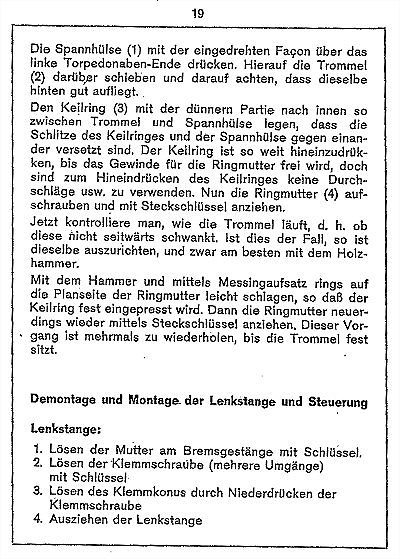 |
Press the adapter sleeve (1) with the
screwed-in thread over the left torpedo hub end. Then slide the
drum (2) over it and make sure that it rests well on the back.
Place the wedge ring (3) with the
thin part in between the drum and the clamping sleeve so that
the slots of the wedge ring and the clamping sleeve are offset
from one another. The wedge ring is to be pressed in until the
thread for the ring nut is released, but to push in the wedge
ring no breakthrough etc. to use. Now screw on the ring nut (4)
and tighten with socket wrench.
Now you control how the drum is
running, i. whether it does not wobble sideways. If this is the
case, it should be aligned with the mallet.
Using the
hammer and brass attachment, lightly beat around on the flat
side of the ring nut so that the wedge ring is firmly pressed
in. Then the ring nut again by means of plug connections!
Attract. This process is repeated several times until the drum
is firmly seated.
Disassembly and assembly of
the handlebar and steering
Handlebar:
1.Loosen the nut on the brake
linkage with a key.
2.Loosen the clamping screw (several
passages) with a key.
3.Loosen the clamping cone by pressing
down the clamping screw.
4.Pull out the handlebar. |
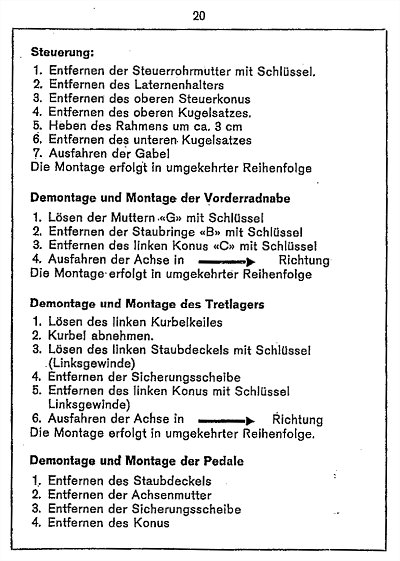 |
Control:
1. Remove the
head tube nut with key.
2. Remove the lantern holder.
3. Remove the upper control cone
4. Remove the upper ball set.
5. Lift the frame by approx. 9 cm.
6. Remove the lower ball set.
7. Extending the fork.
The assembly takes place in reverse
order.
Disassembly and assembly of the front hub
1. Loosen the nuts G with a key.
2. Remove the dust rings B with a key.
3. Remove left cone C with key.
4. Extending the axle In Ó direction.
The assembly takes place in reverse
order.
Disassembly and assembly of the bottom bracket.
1. Loosen the left crank key.
2. Remove the crank.
3. Release the left dust cover with
key (left-hand thread).
4. Remove the lock washer.
5. Remove the left cone with key
(left-hand thread).
6. Extend the axis in ---> direction.
The assembly takes place in reverse
order.
Disassembly and assembly of the pedals
1. Remove the dust cover.
2. Remove the axle nut.
8. Remove the lock washer.
4. Remove the cone. |
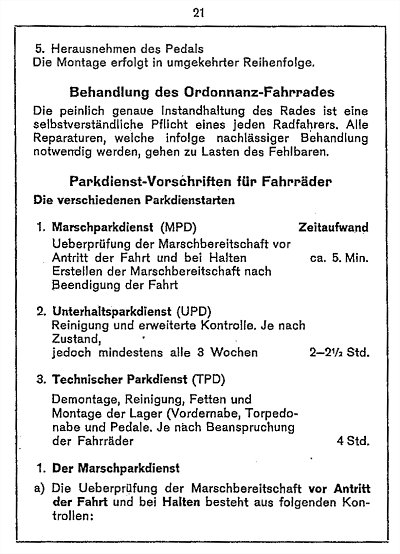 |
5. Remove the pedal.
The assembly takes place in reverse
order.
Treatment of the orderly bicycle
The meticulous maintenance of the bike
is a natural duty of every cyclist. All repairs that become
necessary as a result of careless handling are at the expense of
the defective.
Parking service - Regulations for
bicycles.
The different parking service ticket
1st march park service (MPD)
Check the readiness to march before
starting the ride and keep holding Create the readiness to march
after finishing the drive. Approximately 5 minutes.
2. Maintenance Service (UPD)
Cleaning and advanced control.
Depending on the condition, however, at least every 3 weeks. 2 -
2 Ż hours
3. Technical Parking Service (TPD)
Dismantling .. Cleaning, greasing
and mounting of the bearings (front hub, torpedo hub and pedals,
4 hours depending on the load on the bike.
1. The march park service a)
The verification of the march
readiness before the start of the journey and at the holding
consists of the following controls: |
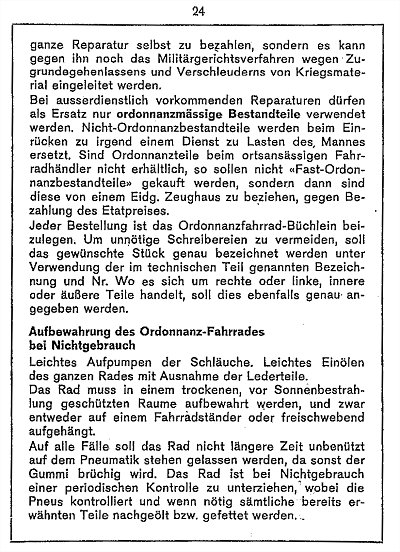 |
to pay for the whole repair
itself, but it can still be instituted against him for the
military court proceedings because of letting go and the
squandering of war material.
For repairs that occur outside of
service, only substitutes may be used as substitutes. Non-order
components will be replaced upon entry into any service at the
expense of the man. Are ordonnanzteile not available from the
local bicycle manufacturer, so should not be purchased
Fast-Ordonnanzbestandteile but, then these are to be obtained
from an Eidg. Arsenal, against payment of the replacement price.
Each order must be accompanied by the
Ordonnanzfahrrad booklet. In order to avoid unnecessary
scribing, the desired piece should be exactly identified using
the name and number given in the technical part. Where this
concerns right or left, inner or outer parts, this should also
be specified.
Storage of the orderly bicycle when
not in use.
Easy inflation of the hoses. Lightly
oil the whole wheel except the leather parts. The bike must be
stored in a dry, protected from sunlight room, either on a
bicycle stand or suspended suspended.
In any case, the wheel should not be
left unused for a long time on the pneumatic, otherwise the
rubber will be brittle. The wheel should be subjected to a
periodic inspection when not in use, whereby the tires are
checked and, if necessary, all the parts already mentioned are
oiled or greased. |
|
|
|
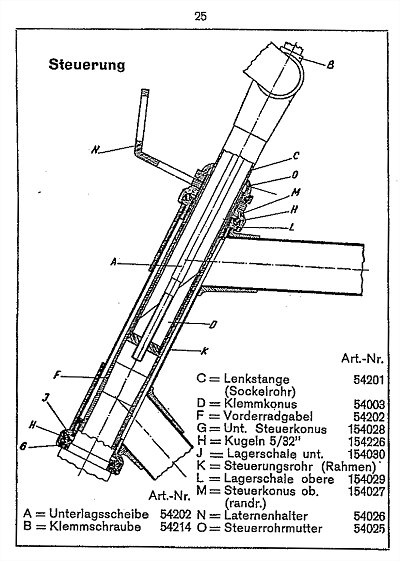 |
|
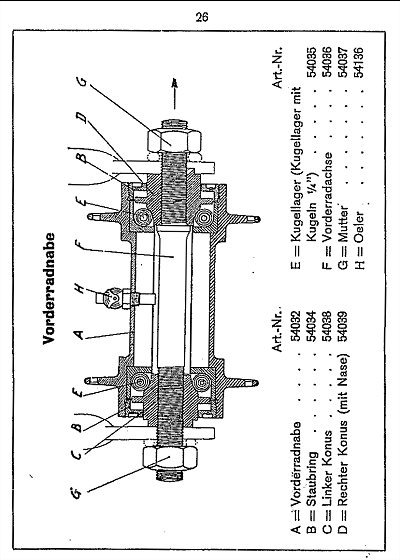 |
|
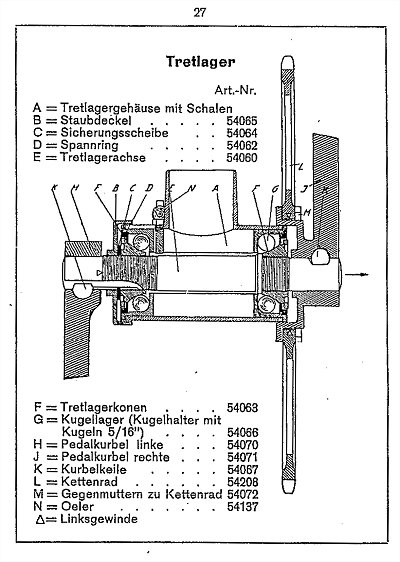 |
|
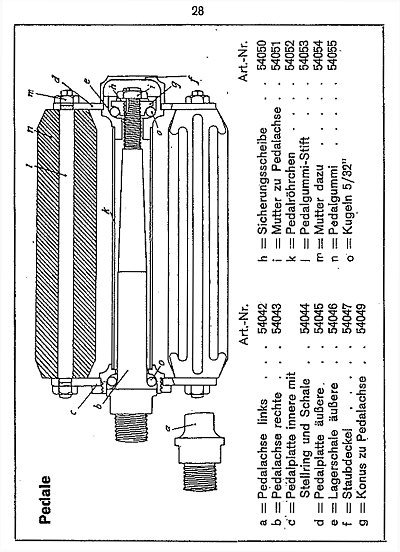 |
|
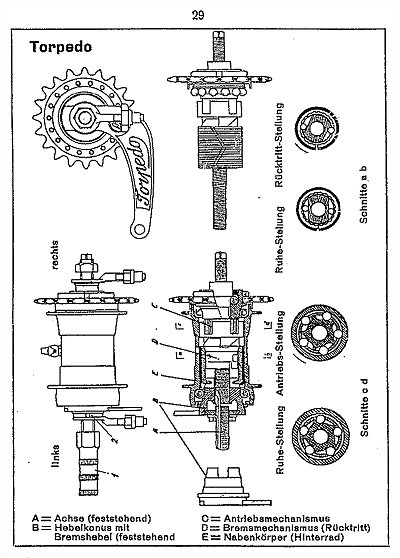 |
|
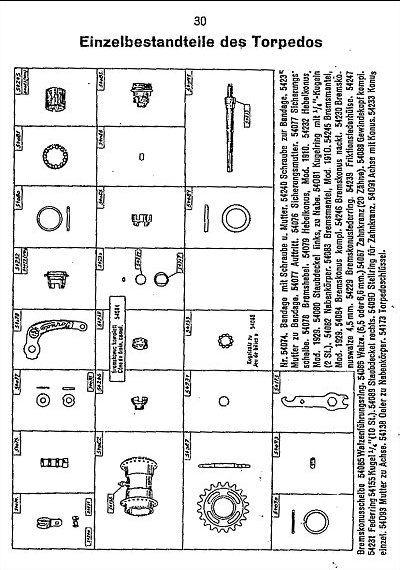 |
|
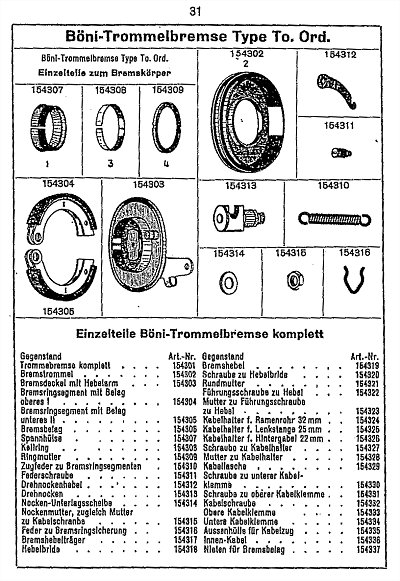 |
|
| |
|